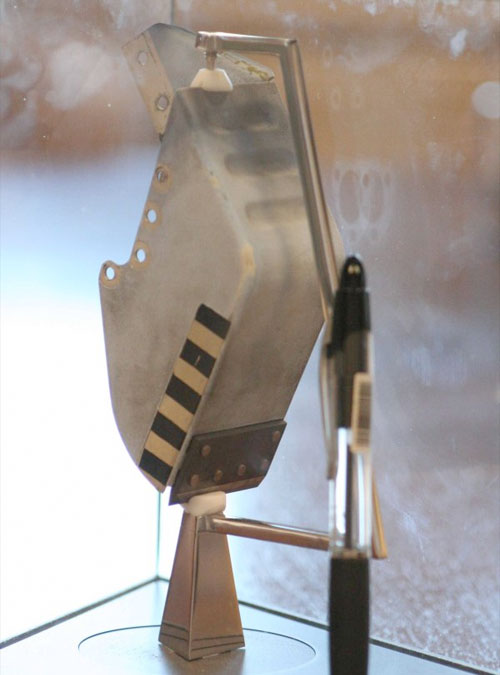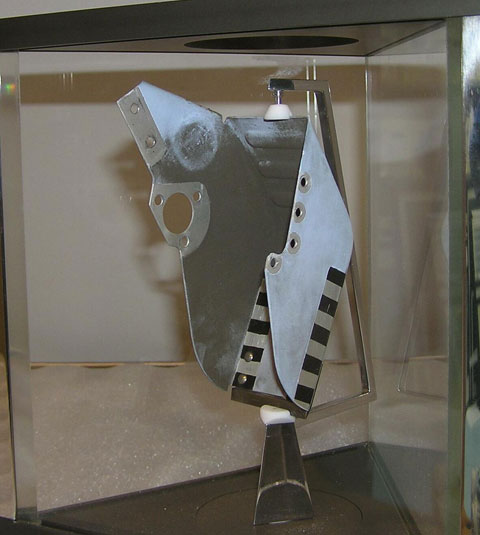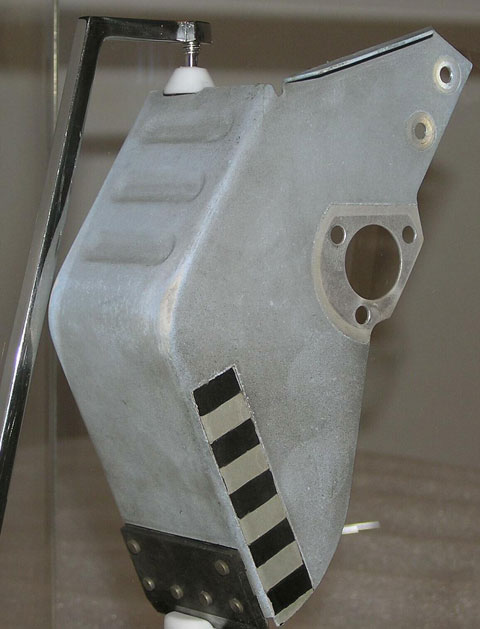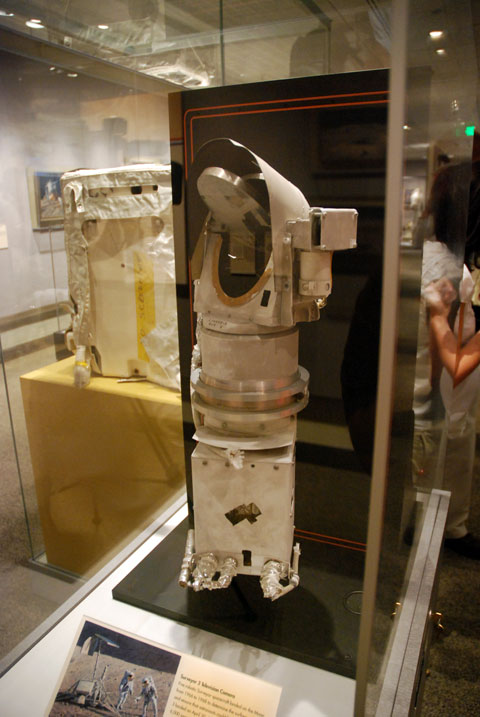|
|

|
|
Author
|
Topic: Apollo 12: Surveyor pieces and microbial life
|
Jay Gallentine
Member Posts: 287
From: Shorewood, MN, USA
Registered: Sep 2004
|
 posted 10-14-2007 06:27 PM
posted 10-14-2007 06:27 PM
   
When Apollo 12 returned Surveyor 3's camera, it was found to contain bacteria that had somehow survived two and a half years in a vacuum. At least, that's what the story was. I've heard some rumblings that the bacteria might have actually snuck aboard after the camera came back. - What is the conventional wisdom with regard to this bacteria?
- Am I correct in understanding that the rock box containing Surveyor 3's camera was sealed on the Moon, in a vacuum, and not opened again until received on Earth by Hughes Aircraft?
|
MCroft04
Member Posts: 1647
From: Smithfield, Me, USA
Registered: Mar 2005
|
 posted 10-14-2007 07:03 PM
posted 10-14-2007 07:03 PM
   
I recall reading that the bacteria might have actually been present when launched, traveled to the moon, survived the harsh lunar climate, and made it back to earth alive. |
SpaceAholic
Member Posts: 4494
From: Sierra Vista, Arizona
Registered: Nov 1999
|
 posted 10-14-2007 08:31 PM
posted 10-14-2007 08:31 PM
   
The camera was actually stashed in a zipper closed backpack with no capability for proper sealing. In-gassing was pretty much ruled out as a representation of the entire microbial population present in the environment would have been expected vice a single strain.Recommend download and review from NASA's Tech Ref Server: Microbial Survival Analysis for the Surveyor 3 starting page 239 - specific answers to your questions are addressed page 241 and onward - Surveyor 3 Camera Results. |
micropooz
Member Posts: 1532
From: Washington, DC, USA
Registered: Apr 2003
|
 posted 10-14-2007 08:39 PM
posted 10-14-2007 08:39 PM
   
Here is a recent development that lends credence to the argument for the microbes being present before launch: Bacteria Find In NASA's Clean Rooms Important To Prevent Life-Search Confusion, The New York Times (10/9, F4, Leary, 1.18M) reports in the "Science Times" section, "Researchers have found a surprising diversity of hardy bacteria in a seemingly unlikely place - the so-called sterile clean rooms where NASA assembles its spacecraft and prepares them for launching." According to a recent study, the Times says, a sampling of several surfaces in NASA's clean rooms "revealed surprising numbers and types of robust bacteria that appear to resist normal sterilization procedures." The authors of the study say the findings are important "because they can help reduce the chances of stowaway microbes contaminating planets and other bodies visited by the spacecraft and confounding efforts to discover new life elsewhere. 'These findings will advance the search for life on Mars and other worlds both by sparking improved cleaning and sterilization methods and by preventing false-positive results in future experiments to detect extraterrestrial life,' said the leader of the study, Dr. Kasthuri Venkateswaran, a microbiologist at NASA's Jet Propulsion Laboratory in Pasadena, Calif." |
kr4mula
Member Posts: 642
From: Cinci, OH
Registered: Mar 2006
|
 posted 10-15-2007 01:37 PM
posted 10-15-2007 01:37 PM
   
Out of curiosity, where are those Surveyor pieces now? Still at the LRL or in some museum? |
Robert Pearlman
Editor Posts: 43576
From: Houston, TX
Registered: Nov 1999
|
 posted 10-15-2007 01:52 PM
posted 10-15-2007 01:52 PM
   
The sample scoop is part of the Kansas Cosmosphere's collection, though it may not be on display. When I interviewed their CEO Chris Orwoll last March, he said, "I think one of my favorite artifacts in the museum is the Surveyor III scoop, but its not on display right now." Surveyor III's camera is on display at the National Air and Space Museum inside the "Exploring The Planets" gallery. |
Robert Pearlman
Editor Posts: 43576
From: Houston, TX
Registered: Nov 1999
|
 posted 06-20-2008 08:30 AM
posted 06-20-2008 08:30 AM
   
Science@NASA feature
Apollo Relic Reveals its Secrets
+ Play Audio | + Download Audio Imagine landing on the Moon, climbing down the ladder of your spacecraft, and looking around the harsh lunar landscape -- to see another, older spacecraft standing only 200 yards away.That's exactly what happened in November 1969, when astronauts Pete Conrad and Alan Bean stepped out of the Apollo 12 lunar module. There, within walking distance on the edge of a small crater, stood Surveyor 3, an unmanned U.S. spacecraft that had landed in April 1967. Apollo 12's landing site had been chosen deliberately near Surveyor 3. The little lander had spent two and a half years exposed to the worst the Moon had to offer: harsh vacuum, intense cosmic radiation, meteoritic bombardment, extreme temperature swings. Back on Earth, NASA engineers wanted to know how metals, glass and other spacecraft building materials held up to that kind of punishment. Inspecting Surveyor 3 first hand seemed a good way to find out. On their second four-hour EVA, Bean and Conrad walked over to Surveyor 3, took dozens of photographs and measurements, and began snipping off parts of metal tubing and electrical cables. They retrieved a camera. The very last thing they removed was a small scoop at the end of Surveyor's extendable arm, which had dug into the dry moon dust and gravel to make mechanical measurements of lunar soil. The little scoop, the camera, and other artifacts returned to Earth were analyzed and then put in storage. At some point in the intervening four decades, the scoop, owned by Johnson Space Center, was transferred on permanent loan to a space museum in Kansas. And there matters quietly lay ... until recently when researchers at NASA's Glenn Research Center (GRC) realized that that little scoop could hold big secrets. Namely, the secrets of digging on the Moon. NASA is returning to the Moon with plans to establish an outpost--and this will inevitably require some digging. The rocky, dusty lunar soil or "regolith" contains many of the natural resources humans need to live. For instance, there is plentiful oxygen bound up in ordinary moon rocks and, in polar regions, deposits of frozen water may lie hidden in the soil of shadowed craters. All that's required is a little excavation. But how? Lunar regolith is not like terrestrial soil. Here on Earth, the sand beneath our feet is shaped by a combination of biological and meteorological forces. Terrestrial soil is moist, rounded by weather, and utterly familiar. Lunar regolith, on the other hand, is a dry, glassy substance pounded into dusty smithereens by eons of meteoritic bombardment. It's not going to respond to a shovel--or a scoop--like terra firma. "To design lunar digging equipment, we need to predict the forces required to move a scoop or other implement through lunar regolith," says Allen Wilkinson, team leader of the ISRU (In-Situ Resource Utilization) Regolith Characterization team at the Glenn Research Center. Surveyor 3 and a sister ship Surveyor 7 actually dug into the Moon and measured how hard their drive motors had to work to scoop, press, and scrape the soil. To interpret those measurements more than 40 years later, however, Wilkinson's team needs to know the dimensions of the Surveyor scoops. Unfortunately, they learned, the blueprints had been lost! Only a scoop itself could provide the answer. That sent Wilkinson to Hutchinson, Kansas, in April 2007 to borrow the Surveyor 3 scoop from the Kansas State Cosmosphere in order to make detailed measurements. Measuring the scoop, however, would prove to be no simple matter. You can't just lay a ruler along the scoop and read off the dimensions. Indeed, you can't touch it at all. The Surveyor 3 scoop is in an airtight triangular container, and NASA curators do not wish the scoop to be removed because handling in air will degrade the historical fidelity of the unique artifact. So the Glenn team borrowed photogrammetry apparatus from the Kennedy Space Center. Photogrammetry is a technique of measuring objects strictly from photographs. They have a photographic studio setup with a white background. GRC team member Juan Agui, an expert in digging force experiments, photographed the scoop in its container next to a standard photogrammetry cube, which has a precise checkerboard pattern on it. Then, using software, Robert Mueller of the Kennedy Space Center extracted dimensions using mathematical triangulation, measuring from points on the scoop to points where corners of dark checks meet on the cube. The software was developed for the Columbia Accident Investigation Board activity. "Photogrammetry is pretty good," Agui remarks. "We got measurements of the scoop accurate to 0.030 or 0.040 inch (~1 mm)." They've since constructed a replica of the scoop and now they are using it to dig into simulated lunar regolith. "Measurements of digging forces are underway," he says. The replicated scoop plunges into a rectangular "soil bed" filled with JSC-1a, a man-made moondust substitute that closely matches the known properties of lunar regolith, while a computer monitors bearing forces. "Our team is quite pleased to find that the measurements appear to be close to reproducing [the best] Surveyor 7 data from the Moon." With this test bed in place, the team can, e.g., move forward to test alternate scoop designs and refine theories of lunar soil mechanics. "Obtaining the Surveyor replica really made the difference," says Agui. The secrets of digging on the Moon are being revealed. |
SpaceAholic
Member Posts: 4494
From: Sierra Vista, Arizona
Registered: Nov 1999
|
 posted 06-20-2008 10:40 AM
posted 06-20-2008 10:40 AM
   
The National Air and Space Museum has a complete Surveyor in DC... why couldn't direct scoop measurements be obtained there? |
Robert Pearlman
Editor Posts: 43576
From: Houston, TX
Registered: Nov 1999
|
 posted 06-20-2008 10:52 AM
posted 06-20-2008 10:52 AM
   
According to the Smithsonian's own entry about their Surveyor: The artifact in the collection is an engineering model, S-10, used for thermal control tests. It was reconfigured to represent a flight model of Surveyor 3 or later, since it was the first to have a scoop and claw surface sampler. Perhaps, the scoop is only a mock-up (given the "reconfiguration")? Also, isn't the Surveyor still hanging from the ceiling over the lunar module? |
Robert Pearlman
Editor Posts: 43576
From: Houston, TX
Registered: Nov 1999
|
 posted 06-25-2008 01:23 PM
posted 06-25-2008 01:23 PM
   
A reader forwarded an explanation by Cosmosphere CEO Chris Orwoll as to why NASA needed the flight article scoop rather than other back-up or mock-up models: The main reason they took the scoop back was that it was used on the surface to dig and they wanted to do detailed measurements of the scoop to see how the surface material eroded the scoop during its digging process. The only way to do that was to borrow the original scoop from us. |
Ray Katz
Member Posts: 145
From:
Registered: Apr 2003
|
 posted 06-29-2008 09:33 AM
posted 06-29-2008 09:33 AM
   
The Surveyor camera that Conrad brought back was at the National Air and Space Museum, but the case there said it was "temporarily removed" a few months back.I don't know if it's back on display or not. |
moorouge
Member Posts: 2458
From: U.K.
Registered: Jul 2009
|
 posted 11-13-2009 06:11 AM
posted 11-13-2009 06:11 AM
   
Does anyone know what happened to the pieces of Surveyor 3 that the crew removed and returned to Earth? Are they stored, destroyed or in someones' collection?Editor's note: Threads merged. |
GACspaceguy
Member Posts: 2516
From: Guyton, GA
Registered: Jan 2006
|
 posted 11-13-2009 06:11 AM
posted 11-13-2009 06:11 AM
   
The scoop is in the Cosmophere in Hutchinson Kansas (pictures taken in early 2006): 
|
Robert Pearlman
Editor Posts: 43576
From: Houston, TX
Registered: Nov 1999
|
 posted 11-13-2009 06:13 AM
posted 11-13-2009 06:13 AM
   
The camera is currently on display in Alan Bean's "Painting Apollo" exhibit at the National Air and Space Museum. |
Robert Pearlman
Editor Posts: 43576
From: Houston, TX
Registered: Nov 1999
|
 posted 05-03-2011 07:27 AM
posted 05-03-2011 07:27 AM
   
Space.com reports that a long-lived bit of Apollo moon landing folklore now appears to be a dead-end affair: microbes on the moon. As it turns out, there's a dirty little secret that has come to light about clean room etiquette at the time the Surveyor 3 camera was scrutinized."The claim that a microbe survived 2.5 years on the moon was flimsy, at best, even by the standards of the time," said John Rummel, chairman of the Committee on Space Research (COSPAR) Panel on Planetary Protection. "The claim never passed peer review, yet has persisted in the press -- and on the Internet -- ever since." The Surveyor 3 camera-team thought they had detected a microbe that had lived on the moon for all those years, "but they only detected their own contamination," Rummel told SPACE.com... "If 'American Idol' judged microbiology, those guys would have been out in an early round," the research team writes of the way the Surveyor 3 camera team studied the equipment here on Earth. Or put more delicately, "The general scene does not lend a lot of confidence in the proposition that contamination did not occur," co-author Morrison said. For example, participants studying the camera were found to be wearing short-sleeve scrubs, thus arms were exposed. Also, the scrub shirt tails were higher than the flow bench level … and would act as a bellows for particulates from inside the shirt, reports co-author Allton. Other contamination control issues were flagged by the researchers. In simple microbiology 101 speak, "a close personal relationship with the subject... is not necessarily a good thing," the research team explains. All in all, the likelihood that contamination occurred during sampling of the Surveyor 3 camera was shown to be very real. |
MadSci
Member Posts: 230
From: Maryland, USA
Registered: Oct 2008
|
 posted 02-19-2012 07:57 PM
posted 02-19-2012 07:57 PM
  
A careful look back at the clean room the procedures followed for the Surveyer and Apollo programs concludes that the colony of Staph. mitis that supposedly hitched a ride to the moon in the Surveyer's camera for several years was just a plain old contamination that occurred here on the ground after camera was returned on Apollo 12.Frankly, this not much of a surprise to those familiar with aseptic and sterile technique, the facilities and procedures of that era are known to be deficient, and given that the bacteria was the ubiquitous Staph. we can probably put this tall tail to rest. Editor's note: Threads merged. | |
Contact Us | The Source for Space History & Artifacts
Copyright 2020 collectSPACE.com All rights reserved.

Ultimate Bulletin Board 5.47a
|
|

|
 advertisement advertisement

|















